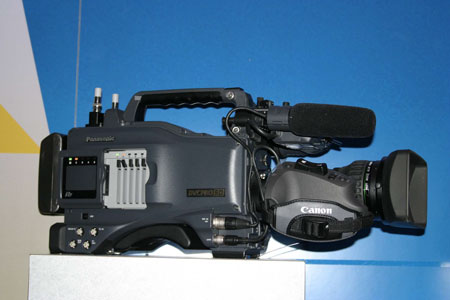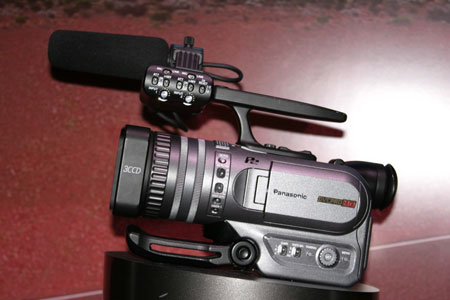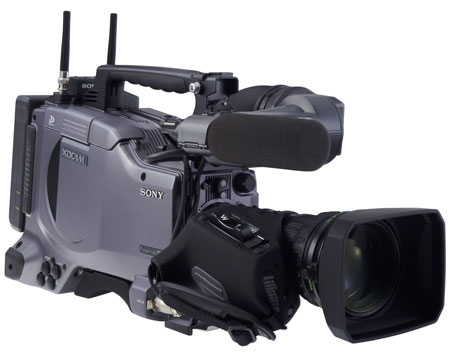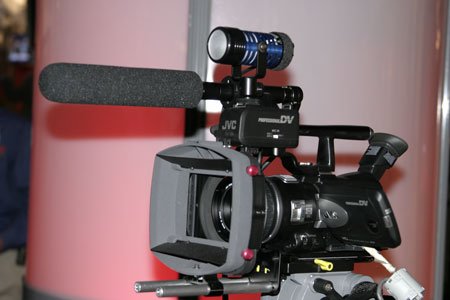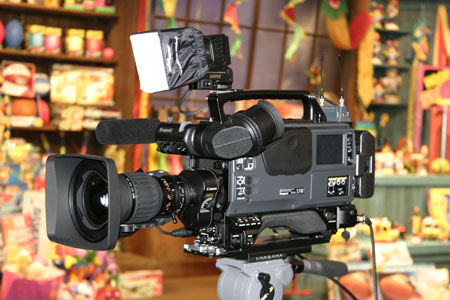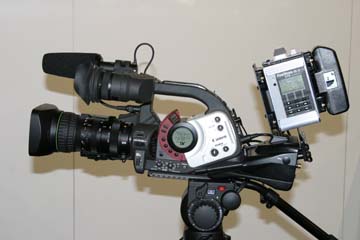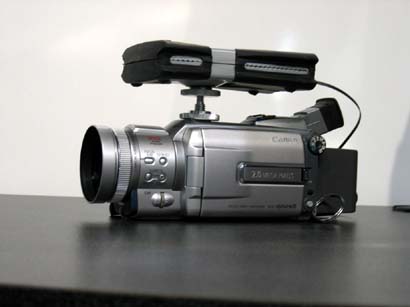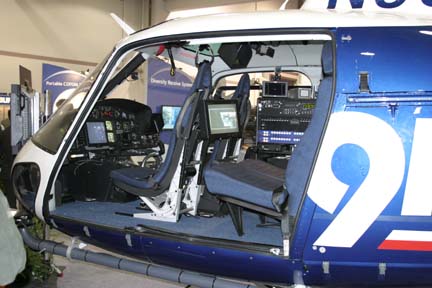 |
→ May 2004 Contents → Special Report
|
 | |
Cameras of the NAB
May 2004
|
|
|
If the 2004 show of the Photo Manufacturers' Association in Las Vegas was all about digital, last month's exhibition of the National Association of Broadcasters in the same city was all about High-Definition television and the move to tapeless cameras. The annual show is one of the biggest that Las Vegas hosts. This year 97,544 attendees, from broadcast and Internet organizations, pounded miles of halls in the three huge buildings that house the exhibition. They were generally in a mind to buy: everything from cameras and edit bays, to microwave and digital production systems, right up to spiffy news helicopters. This is a reflection of the improved economy and, more importantly, of the mandated change from analog to digital among broadcasters and cable and satellite operators. The following is an overview of some of the exciting new products we saw in the 4-day show: HIGH-DEFINITION AND TAPELESS CAMERAS The product that caused the greatest buzz in the Central Hall was Panasonic's new P2 system. Panasonic is convinced that the days of tape being used as an acquisition medium are numbered. Its new family of cameras does away with tape transports, which is one of the most trouble-prone elements in cameras. Also, newsrooms need to move video faster through the editing process; using solid-state memory rather that tape or discs achieves that purpose.
Panasonic's new flagship ENG camera, the AJ-SDX800 camcorder, shares the same high-quality front end as its hit camera of 2003, the SDX900 (see our review by Steve Smith - The Versatile Panasonic SDX900 Camcorder). At the time we called this the best ENG for the money in the business. With a 24fps recording option and native 16:9 wide-screen format, it was one of the best-selling cameras to pros following its introduction. The new 800 looks just like the 900, with one exception: where the tape recorder used to be, there are slots in the side of the camera that accommodate up to five DVC PRO P2 memory cards, which are just slightly larger than flash cards used in digital still cameras. They come in two gigs to 128 gigs. A four-gig card will record 40 minutes of DVC PRO signal. Once acquisition is complete you can plop the disc right into your laptop's PCMIA for instant editing, or into an AJSPD850 deck. This allows for instant editing, which can then be routed to a newsroom server. The cards are reusable up to 100,000 times. The rub is that a four-gig card costs $2,000 each. That means that the average camera operator would probably carry five cards, which means a $10,000 investment in memory chips. However, a broadcast or production company would soon cover the cost by not having to buy tape. Also, for a business the fact that each card carries a serial number means that it becomes a capital investment, rather than an expendable like tape. The 800 is now in stores for $19,500, minus lens and viewfinder, which is actually $2,000 less than its predecessor, the 900.
Panasonic DVC Pro P2 For video journalists, the big question, of course, is when will this technology be available in smaller "palmcorders?" The answer for now is that no one is sure. Panasonic showed balsa-wood models of planned cameras, the P2-DVCPRO palmcorder and the P2-DVCPRO-50, that look similar to its hit 24fps tape camera introduced last year. But there are a lot of issues that need to be resolved in this area. While Panasonic is banking on memory cards, Sony is placing its bet on optical discs. At NAB Sony introduced its PDW510 optical digital camera. It utilizes what looks like a DVD, which only costs $30 per disc. A 23-gig disc will record 85 minutes in the DV Cam format. It is a 16:9 camera with an optional 24fps feature, as well as an Ethernet out for instant connection to a computer. Like the Panasonic, this camera can speed up the editing process exponentially, since there is no need to render tape. The camera will sell at a reasonable $18,000, minus glass.
On the smaller camera front, Sony showed its new PD170, which is the replacement for the popular PD150. It looks about the same but adds a wide-angle converter as standard equipment, which gives the built-in lens a 7x wider view. It has a bigger and brighter LCD, and the operator can look through both the LCD and viewfinder simultaneously. It is much better in low light, with a 1- lux rating. The camera will sell for $3,940 retail. Last summer JVC dropped a bombshell in the prosumer video industry when they introduced the first small HD camera, the HD10U. The New York Times raved about it, but it quickly became obvious to pros that there was a major drawback: there was no way to edit the tape. That is because the HD MPEG2 compression raised havoc with time code.
In the past six months, JVC has been busy solving that problem, turning to software partners such as Pinnacle, Canopus, and Avid for help. These partners came up with solutions for PCs and recently Lumiere has developed a $399 tool kit that works with Mac and Final Cut Pro . Although the results look good in a monitor, professionals who have used the system still report problems with the picture quality, especially in things like fast pans, which the picture just can't handle.
Ikegami, one of the most expensive ENG cameras in use, with a terrific reputation among news professionals, actually was the first to move into the tapeless environment 10 years ago. Ikegami has refined its cameras based on experience and in Las Vegas showed its new DNS33W, combining excellent front-end elements with a new NTT hard drive that slips into what used to be the tape deck. The hard drive costs $500 for 20 gigs, which would give the operator about an hour of recording time. An 80-gig drive, which would deliver over four hours, costs only $800.
So, by this time, the reader must be saying, "Well, what about Canon?" As you know from reading our many reviews of Canon camcorders, starting with the introduction of its industry-shaking XL-1, Canon has a unique policy of watching and waiting when it comes to new developments. It watches what other manufacturers do, then takes into account what its customers want before producing new products. This is certainly the case with High-Definition and 24fps. It's one thing to create an HD system for an ENG camera, with lenses alone costing $20,000, and quite another to design that kind of system for a camera that will list at a cap of $6,000, if you want to maintain a reputation for innovation and quality. Canon only had two new cameras to show at NAB, both in the low-end price range. It introduced a new version of its Optura line for about $899, featuring a 2.2 meg chip and a RGB color filter, which emulates a three-chip camera, along with volume controls for audio. It also showed two new little ZR cameras, the 30 and 40, with the same RGB filter and full-frame 16:9. There is no doubt that Canon is busy on a new camera to replace the XL-1S. In the past, it has always introduced these cameras in the fall, in time for the New York Photo Show; I have no reason to believe this year will be any different. While HD is probably not an option at this time, you can expect many of the subjects we have discussed in this report to be addressed. But what about this whole "tapeless" camera thing? How do you get into that with your XL-1S or GL? Well, Canon demonstrated the answer in Las Vegas. Actually it is not that radical. Several years ago we did a review on a product called "The FireStore." It was an innovative hard drive that allowed tape to be transferred into digital format, or could be used as a bypass to record directly onto the hard drive. When we reviewed it, we told its creator, Matt McEwen of Focus Enhancements, that it was interesting, but it was made a shelf unit, and we felt it belonged on the camera. The company immediately came up with a pouch and cable with battery that would make it portable, but that answer was underwhelming. Now, the FireStore is back, this time mounted on the rear plate of an XL-1S. This turns the camera into a "tapeless" camera, with up to five hours of recording capability, that can be plugged by FireWire directly into your laptop and Final Cut Pro.
Then, just as I was getting ready to leave the show, a young entrepreneur, Arnold Ramirez, came by the Canon booth with a new invention. Called the QuickStream DV, it is a portable hard drive about the size of a pack of cigarettes. With a bracket that allows it to be attached to the hot shoe atop any camera, it does the same thing the other hard drives we have discussed do. It comes in four models, starting at $599 for 1.5 hours of recording time, up to a 6-hour model at $999. It supports all video editing software, so when you are done shooting, you simply unplug the QuickStream DV from your camera's FireWire port, plug it into your NLE system's FireWire port and begin editing your footage immediately. Can Canon now be called a tapeless system? If you want, Yep!
DON'T LEAVE HOME WITHOUT IT Finally, there was one item shown at NAB which every Platypus ought to have in his or her garage. Helinet Aviation Services is selling a spiffy Eurocopter A Star, featuring a Cineflex HIDEF camera, which allows for helicopter transmissions without any loss of HD image quality. The five-seater is able to operate at up to 200 mph with a 560 mm zoom lens extended to a full 1120 mm, and features the ability of a 360-degree tilt and a +/- 165-degree tilt and a +/- 45-degree roll. Optional features include two 50 mm machine-gun door mounts, which are useful for supporting news crews on the ground. This great piece of equipment can be yours for only $2,000,000. Leases are available through Helinet Aviation Services at http://helinet.com.
© Dirck Halstead
|
|
Back to May 2004 Contents |
|
